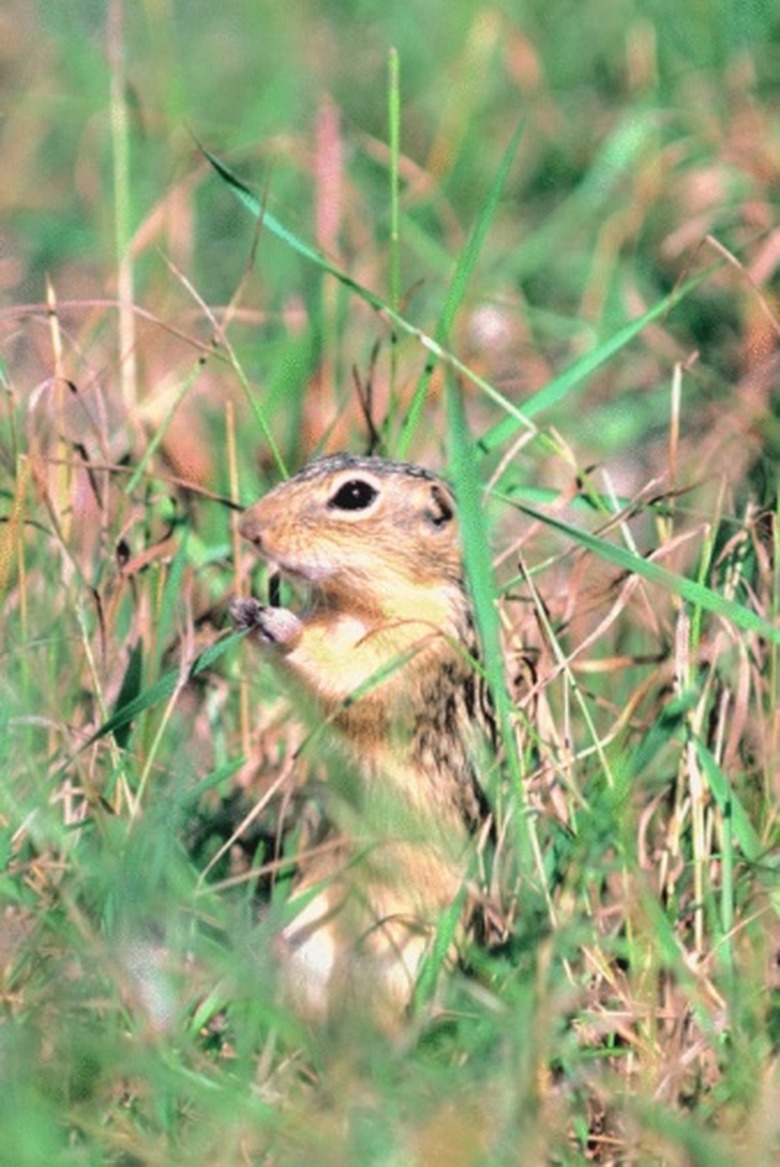Rodents That Tunnel Underground & Then Surface
A little nose poking up out of the ground signals the presence of a tunneling rodent. Damage from these rodents ranges from mild to highly destructive. Trapping a tunneling rodent takes time and patience. Check your county and state laws regarding relocating a wild animal.
Gophers
Gophers
A member of the Thomomys species, pocket gophers are a burrowing rodent found across North America and in the northern regions of Central America. Camouflaged by their brown fur, these rodents dig vast systems of tunnels with their powerful front claws. Favoring moist soil, they are often found in gardens, farms and household lawns. Fresh mounds of dirt mark a gopher's tunnel. Loose dirt from digging the tunnel is pushed to the surface creating the mound. These highly destructive rodents don't hibernate, so garden and plant damage can occur through the year. Gnawing on plastic sprinkler systems, trees and shrubs keeps their continuously growing teeth in check. To trap a gopher, locate the burrow's entrance and place a box or pincher trap directly in front of it. Bait the traps with fresh vegetables then cover it with a piece of sod. Once caught, level the current mounds and watch for reinfestation.
- A little nose poking up out of the ground signals the presence of a tunneling rodent.
- Once caught, level the current mounds and watch for reinfestation.
Moles
Moles
Indigenous to North America, Asia and Europe, moles have enlarged front feet designed to tunnel in moist soil. Roughly 5 to 8 inches long, moles can dig an 18-foot-long tunnel in one hour. Unlike gophers, moles don't damage plants for food. Earthworms and small invertebrates comprise a mole's diet. Moles eat 45 lbs. of worms and insects annually. The tunnels and mounds moles create to find worms and insects indirectly kill grass and yard plants, thus awarding them a pest status in most people's minds. Mounds created by moles are raised volcano-shaped piles of dirt. Tunneling just below the surface, moles create a raised ridge of dirt between each mound. Trap moles in the spring and fall when moist soil keeps them close to the surface. Locate active tunnels by collapsing a few tunnels then watch to see which ones are rebuilt within a few days. Place the traps along those tunnels.
- Indigenous to North America, Asia and Europe, moles have enlarged front feet designed to tunnel in moist soil.
- Trap moles in the spring and fall when moist soil keeps them close to the surface.
Pine Voles
Pine Voles
Found throughout the Eastern United States, pine voles resemble a small brown mouse. Ranging from 3 to 4 inches long, their stocky bodies still weigh less than 2 oz. Digging an extensive burrow and tunnel system roughly 1 foot below the surface, they are difficult to trap. Eating small plants and flower bulbs, voles can quickly kill raised beds, gardens and orchards. They gnaw on a tree or an ornamental shrub's underground root system often killing the plant. Trapping is not necessary. Encourage the vole to relocate its burrow to a safer location by tilling the tunnel area or disturbing entrance holes. Disrupt the tunnels and entrance holes for two weeks and the vole will usually move to a new and safer burrow.
- Found throughout the Eastern United States, pine voles resemble a small brown mouse.
- Disrupt the tunnels and entrance holes for two weeks and the vole will usually move to a new and safer burrow.
Chipmunks
Chipmunks
Part of the squirrel family, the chipmunk's striped body is easily identified. Roughly 5 to 6 inches in length, they have five stripes running from the back of their heads to their tails. Chipmunks are found across North America and Asia. Solitary in nature, a chipmunk's territory may overlap if enough food is available. Well hidden, chipmunk burrows and tunnel systems can stretch over 30 feet long. Tunnel systems include a nesting chamber, a nursery, several food chambers and multiple escape exits. Considered only a minor agricultural pest, chipmunks eat flower bulbs, nuts, grass seed, bird seed and pet food. Trapping is an option if the chipmunk's presence cannot be tolerated.
- Part of the squirrel family, the chipmunk's striped body is easily identified.
- Well hidden, chipmunk burrows and tunnel systems can stretch over 30 feet long.
